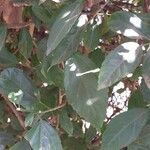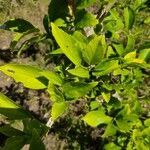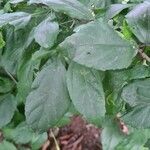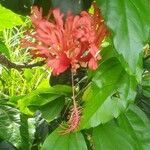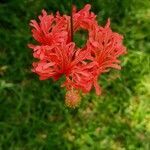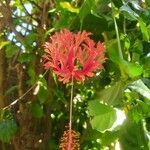Shrub up to 4 m high, glabrous or nearly so. Leaves rather short-petiollate, the petiole slender, up to 1.7 cm long, canaliculate and stellate-hirtellous above, the stipules subulate-filiform; blade elliptic to narrowly elliptic, acute to obtuse at the base, acute at the apex, serrulate-denticulate at the margin, up to 6 cm long and 2.5 cm wide, glabrous, usually 3-palminerved, the nervation slightly prominent beneath. Flowers showy, solitary in the upper leaf axils, pendent, the pedicels very long, slender, articulated near the middle, up to 14 cm long, glabrous to minutely papillate; epicalyx none or the bractlets usually very minute; calyx tubular-cam-panulate, irregularly lobed, 15-20 mm long, spathaceous, glabrous or minutely papillate; petals reflexed, obovate, long-unguiculate, deeply pinnately dissected into numerous oblong or= spatulate lobes, 4-7 cm long, pink or red; staminal tube slender, 5-lobulate at the apex, well exceeding the corolla and up to 9 cm long, antheriferous on the upper part, the filaments up to 7 mm long; style much longer than the staminal tube, the style branches ca 10-12 mm long, the stigmas fimbril-late. Capsule oblong-cylindraceous, obtuse, the seeds glabrous.
Shrubs evergreen, erect, to 3 m tall. Branchlets slender, usually pendulous, glabrous. Stipules subulate, ca. 2 mm, usually caducous; petiole 1-2 cm, stellate; leaf blade elliptic or oblong, not lobed, 4-7 × 1.5-4 cm, papery, glabrous, base obtuse or broadly cuneate, margin dentate, apex acute or shortly acuminate. Flowers solitary, axillary on upper branchlets, pendulous. Pedicel slender, 8-14 cm, glabrous or slightly hairy, articulate in middle. Epicalyx lobes 5, lanceolate, 1-2 mm, ciliate, apex obtuse or acute. Calyx tubular, ca. 1.5 cm, sparsely hairy, 5-lobed, usually dehiscent on 1 side. Petals 5, red, ca. 5 cm, deeply pinnatifid, strongly reflexed. Staminal column longer than corolla, 9-10 cm, glabrous, curved upward toward tip; anthers restricted to upper part. Style branches 5, glabrous. Capsule oblong-cylindric, ca. 4 × 1 cm. Fl. year-round.
An evergreen shrub. It grows 3 m high. The young branches are slender. The leaves are narrowly oval and 4-7 cm long by 2-4 cm wide. There are teeth towards the top end. The flowers are scarlet. They hand down. The fruit are capsules 4 cm long and 1 cm wide.
